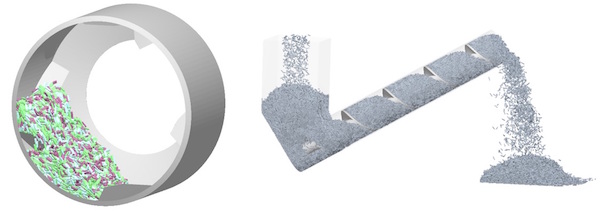New Frontiers in GPU Acceleration
From molecular science and material flow to sound propagation, GPU cores take on new workloads.

Examples using polyhedral particles: chewing gum in drum mixer and pellets in screw auger. Image courtesy of Altair.
Engineering Resource Center News
Engineering Resource Center Resources


Latest News
March 5, 2021
GPU acceleration is often associated with photo-realistic renderings and real-time graphics, but the latest developments in the industry point to a rapid expansion of the applications.
CFD (Computational Fluid Dynamics) analysis is generally associated with airflow and heat flow in confined spaces, but not with material flow, such as the loading and dispensing of rocks and sand in construction. This is the focus of engineering software maker Altair’s EDEM. A variation of Finite Element Method, the application is dubbed Discrete Element Method (DEM) by the company. It’s shown to benefit from GPU acceleration.
The latest version of EDEM shows significant improvements thanks to GPU acceleration. The polyhedral particle solver runs on NVIDIA CUDA GPU cards. It is compatible with the EDEM API and the coupling interface for coupled simulations with CFD and Multi-Body Dynamics solvers. The EDEM multi-sphere GPU solver has been optimized, providing a speed improvement of up to 30%, according to the company. (The graph below shows GPU speed-up between EDEM 2021 and previous versions.)
.jpg)
Similarly, in video games’ virtual worlds as well as real-life architecture, NVIDIA VRWorks-Audio is elevating audio simulation’s potential, accurately reproducing what you would hear as though the mesh-constructed castles and mansions were real structures. This too is another area where the GPU can make a difference.
GPU-Accelerated Rock and Roll
Altair acquired EDEM in November 2019, allowing it to augment its machinery and materials simulation packages with EDEM. In mining, heavy equipment, and pharmaceutical operations, EDEM can be used to analyze and optimize the flow of rock, sand, asphalt, and pills, among others. EDEM’s particle behavior simulation system benefits from GPU acceleration.
In announcing updates to EDEM 2021, the company revealed, “The polyhedral particle solver has been designed for high performance cards and runs on Nvidia CUDA GPU cards. It is compatible with the EDEM API and the coupling interface for coupled simulations with Computational Fluid Dynamics (CFD) and Multi-Body Dynamics solvers.”
EDEM can also be coupled with MotionSolve, Altair’s multibody mechanical analysis program, to simulate heavy equipment operations involving bulk materials.
Rocky DEM from ESSS also leverages GPU acceleration for particle simulation. Last year, the company announced that Oracle Cloud had made NVIDIA's A100 Tensor Core GPUs available on its infrastructure so that Rocky DEM users could accelerate solving more complex and larger problems in the particle dynamics space. In benchmarking, using GPU 4.8 machines with NVIDIA A100 GPUs provided a 40% performance improvement versus running on a single GPU. Processing multi-GPUs simulations in this configuration showed significant improvement.
.jpg)
“This higher communication bandwidth between all GPUs, which results in lower latency, has proven to be key in achieving better scalability as more GPUs are added. The benefit to Rocky DEM users is the critical performance gains that result from combined processors available in each of the NVIDIA GPUs — as well as from stacking the memory from multiple GPUs to run cases that do not fit into a single GPU,” said Clovis Maliska Jr., President of ESSS.
Rocky DEM is also integrated with applications within the Ansys Workbench platform. This enables simulations such as a wide range of granular-fluid systems using Rocky DEM and Ansys Fluent. The coupling between the DEM tool and Ansys Mechanical can allow engineers to predict the stress responses of structures when subjected to granular loads that have been accurately calculated in Rocky DEM.
Facing the Music
You cannot not see how sound travels, but you can certainly hear it. Certain seats in a concert hall may suffer from poor reception; certain corners in a car may be beyond the reach of the speakers.
With VRWorks-Audio from NVIDIA, acoustic engineers can hear audio in a virtual environment, as though the walls, domes, and basements constructed with pixels have physical properties. This helps the engineers pinpoint areas with too much echoes or reverberation, and finetune the audio experience of a space.
Much like ray-traced rendering, VRWorks-Audio simulates audio effects by tracing the sound’s path from the audio source, calculating its trajectories as it comes in contact with the nearby objects.
“Leveraging NVIDIA OptiX ray tracing technology, VRWorks Audio traces the path of sound in real-time, delivering physically realistic audio that conveys the size, shape, and material properties of the virtual environment you are in,” the company explains.
Available as a plug-in for Unreal Game Engine, VRWorks-Audio is compatible with Maxwell, Pascal and Turing based GPUs (GeForce GTX 900 series and higher, Quadro M5000 and higher). VRWorks-Audio SDK 2.0, the latest version, includes support for NVIDIA Turing RTCores and NVIDIA OptiX 6.
Molecular Science
With ramped up vaccine activities in the fight against COVID, the demand for simulation in life science is expected to grow. Anticipating the need, workstation vendors have targeted the molecular dynamics space with workstations, HPC clusters, and multiuser servers that can run these large-scale simulations.
Molecular dynamics simulations compute atomic trajectories by solving equations of motion numerically using empirical force fields, and simulation of large molecules requires a large amount of computing power. HPC and supercomputing systems are increasingly being upgraded with GPU processing to help boost performance for these complex simulations. Previous benchmarks from NVIDIA have shown a 3X to 8X speed improvement over CPU-only systems for these molecular dynamics applications.
A good example was the Folding@Home crowdsourcing initiative, which leveraged GPU-based exaflop processing power for COVID-19 research. Last year, the GROMACS HPC molecular dynamics application further improved its GPU-accelerated performance by shifting the entire timestep to the GPU, avoiding CPU and PCIe bottlenecks.
More Altair Coverage
More NVIDIA Coverage
Subscribe to our FREE magazine, FREE email newsletters or both!
Latest News
Related Topics





